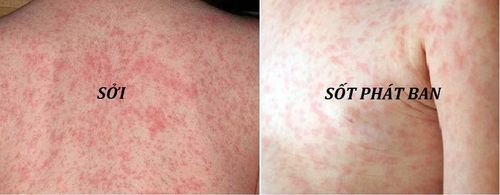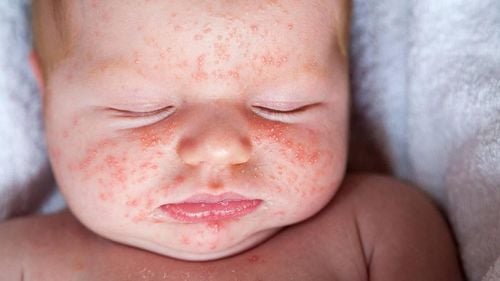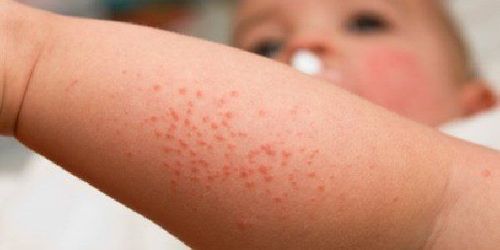This is an automatically translated article.
Measles typhus is a fairly common disease in recent years. Especially if the disease is not treated early, it can easily spread and become an epidemic. Especially when young children have poor resistance, their immune systems are not yet complete, they can easily spread the disease and leave many dangerous complications.1. What is measles typhus?
Measles typhus is caused by the measles virus. The disease is clinically characterized by fever, inflammation of the respiratory tract, gastrointestinal tract, conjunctivitis of the eyes, and an orderly rash.Measles typhus in children is most common in children aged 6 - 36 months. However, it is also possible to experience measles-like typhus in adults who have not been vaccinated or have been vaccinated but have not been vaccinated.
The disease is spread by respiratory route, when breathing the same air source with an infected person. The measles virus spreads through the air and penetrates the respiratory mucosa (such as sneezing), so the disease spreads quickly in the community, if not well controlled, it can cause an epidemic.
2. Signs to recognize measles typhus fever
The symptoms of measles-like typhus are easily confused with those of Rubella (also known as German measles). In addition, the measles rash can be mistaken for an allergic rash, so patients are often subjective.Signs to identify measles typhus fever is through the symptoms of each disease stage:
Incubation period: The incubation period is about 8-11 days. Patients often have no obvious symptoms. If it is an infant, it can last 14-15 days. Initiation phase (secretory inflammation): Normally, this stage begins about 3-4 days. The patient suddenly had a mild or moderate fever, followed by a high fever. Accompanied by symptoms such as inflammation of the nose and throat, runny nose, cough, conjunctivitis, rusty eyes, swollen eyelids; Cough, sneezing, runny nose, then laryngitis may occur. Full-blown stage (rash phase): The rash appears on the 4th - 6th day of the disease. When the rash begins to grow, the patient will have a high fever, and the body will be tired. When the rash reaches the feet, the temperature will gradually decrease and then go away. Usually on the 6-7th day, you start to fly, leaving bruises with thin, smooth skin. The patient's whole body recovers gradually if there is no superinfection, complications... The rash form is a maculopapular rash, a small, slightly raised rash on the skin, alternating with pink maculopapular rash. The rash is scattered or widespread and adheres to each other in circular clusters, between the rash is a healthy skin. The rash develops in order, on the 1st day it grows behind the ears and spreads to the face. Day 2 spread down to the chest, hands. Day 3 spread to the back, legs. The rash lasts 6 days and then flies in the same order as it sprouted. When the rash grows in the gastrointestinal tract, it will cause digestive disorders, loose stools; in the lungs causing bronchitis, cough.

Ở giai đoạn khởi phát, người bệnh đột ngột sốt nhẹ hoặc vừa, sau sốt cao
3. Complications of the disease
When the disease is not treated or the patient self-medicates, it leads to superinfection and complications such as:Respiratory complications: Laryngitis: In the early stage, it appears at the onset or with false Croup, causing shortness of breath due to laryngospasm. In the late stage due to superinfection (common due to staphylococci, streptococci, pneumococci...), appearing after the eruption of the rash. The course is often severe such as high fever, cough, hoarseness, shortness of breath, cyanosis. Bronchitis : Usually due to superinfection, appearing at the end of the rash period. Symptoms of fever again, cough a lot. Bronchopneumonia: Due to superinfection, it often appears late after the rash develops. Severe illness with high fever, difficulty breathing, pulmonary examination with bronchial rales and crackles. It is the leading cause of death in measles, especially in young children. Neurological complications: Encephalitis: This is a dangerous complication with high mortality and sequelae. Seen in 0.1 - 0.6% of patients with typhus and measles. Common in older children (school age), in the first week of rash (day 3 - 6 of the rash). Sudden onset, high fever, convulsions, disturbances of consciousness: coma, paralysis of 1/2 body or 1 limb, paralysis of cords III, VII, or pyramidal - extrapyramidal syndromes, cerebellum, vestibule. .. Serous meningitis (caused by measles virus). Myelitis: Paralysis of the lower extremities, sphincter disorders. Purulent meningitis due to superinfection: Purulent meningitis after otitis, sinusitis, pharyngitis... due to superinfection. Subacute fibrotic leukoencephalitis (Van Bogaert): Common at the age of 2-20 years old, appearing late, sometimes after a few years, this indicates that measles virus can live latently in the patient's body for many years. in patients with an abnormal immune response. Subacute development from a few months to a year. The patient died in the state of hypertonia and cerebral spasticity. Gastrointestinal complications: Oral mucositis, late onset, due to superinfection with spirochetes Vincent (Leptospira vincenti) is a type of gangrene spirochete, causing ulceration of the oral mucosa, spreading widely into the jawbone causing mucosal necrosis, osteomyelitis, tooth loss, bad breath). Enteritis: Due to superinfection of bacteria such as Shigella, E.coli...
4. Treating typhus at home for children
Reducing fever for children: When typhus fever in children, parents need to monitor the child's temperature and reduce fever when necessary by:Loosen clothes for the child; Warm the child for no more than 10 minutes/hour; Give the child hypothermia or put an rectal antipyretic for the child; In case the child still has a fever, give them paracetamol at a dose of 10mg - 15/1kg/time at least 6 hours apart. Replenish water and electrolytes for children: Parents should give children plenty of water such as juice, soup or oresol. After fully rehydrating electrolytes and reducing fever for children, parents need to continue to monitor. Nutrition for children: Children need to eat enough nutrients, pure, liquid, easy to digest foods, which need to be increased in both quality and quantity. Children should eat more than usual, divide them into many meals and give priority to foods that are easy to digest. Breastfed babies continue to breastfeed. However, when measles-like typhus fever in children is not controlled with fever despite being given antipyretics, the rash does not improve after 3 days, children with weak immune systems, children under 6 months old or If parents suspect that the child is dehydrated due to diarrhea, please take the child to a specialized medical facility for timely examination and treatment.

Phụ huynh nên cho trẻ uống nhiều nước như nước hoa quả, súp hoặc oresol
5. Measles typhus prevention
Measles vaccination is the most effective way to prevent typhus and measles, children will receive the first dose when they are 9 months old and the second booster shot when they are 18 months old. However, it is necessary to get an injection before coming into contact with someone who has measles. When the child has a fever of unknown cause, it is necessary to isolate and limit going to crowded places. Full complement of nutrients for the growth of children. Keep the house, place, water source and hygiene for children clean. Vinmec International General Hospital is currently providing a Package Immunization Program with a variety of vaccines for different audiences, from infants, young children, adults, and women before and during pregnancy pregnant.Particularly in December 2019, Vinmec will give you free newborn Hepatitis B Vaccine (immunization right after birth) for your baby when you sign up for a Package Immunization Package for children aged 0-1 or 0-2 year old .
Please dial HOTLINE for more information or register for an appointment HERE. Download MyVinmec app to make appointments faster and to manage your bookings easily.













